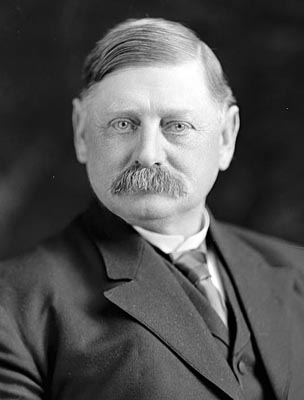Listen to this article
Our series on Colorado’s governors continues with John F. Shafroth, Colorado’s 18th governor. Governor Shafroth served two terms from 1909-1913 – the first governor in Colorado to be elected to two consecutive terms. Honest John Shafroth: a Colorado reformer, a History Colorado publication, details Shafroth’s life and contributions to Colorado politics.
Early life

John Franklin Shafroth was born in Fayette, Missouri in 1854 to Swiss immigrants. He pursued a law degree at the University of Michigan, which he earned in 1875. Shafroth worked as a law partner back in Fayette before moving to Denver in 1879. By 1881, he had earned enough money to propose to his childhood friend, Virginia Morrison. She left her teaching job and moved from Fayette to Denver. They were married on October 26, 1881.
Political career
Shafroth first became involved in politics in 1882, when he worked as an assistant to a Denver prosecutor. He served in his first public office after being elected Denver City Attorney for two terms, from 1887-1891.
Although he had limited experience in federal politics, Shafroth was elected to the U.S. House of Representatives as Republican in 1894, 1896, and 1898. He switched political parties in 1900 and won a House seat as a Democrat. While in Congress, Shafroth fought for women’s right to vote and for economic development of the West.
In 1902, Shafroth resigned his seat after his opponent accused him of election fraud. Actions like this earned him the nickname “Honest John.”
Shafroth returned to politics when he ran for governor as a Democrat in 1908. He was inaugurated on January 12, 1909. In his inauguration speech, Shafroth set the stage for the campaign reforms he would advocate for during his two terms. As the “reform governor,” he overcame an unwilling General Assembly to pass direct primary law, direct election of senators, an anti-corruption act, and more.
When his second term as governor ended in 1913, Shafroth was elected to the U.S. Senate. Back at the federal level, he continued advocating for women’s suffrage and worked to pass public land laws for the Western states. After being unseated in 1918 by Lawrence Phipps, he served as the chairman of the War Minerals Relief Commission.
Life after politics
Near the end of his life, Shafroth worked in private law practice and supported others entering into politics. He died in 1922 and is buried in Denver’s Fairmount Cemetery. His personal and professional papers are held in the Denver Public Library’s Western History and Genealogy collection.
- Understanding Colorado’s electric vehicle tax credit - February 24, 2025
- Colorado State Parks: Roxborough - February 7, 2025
- A snapshot of homelessness through Colorado’s Point-in-Time Count - January 24, 2025